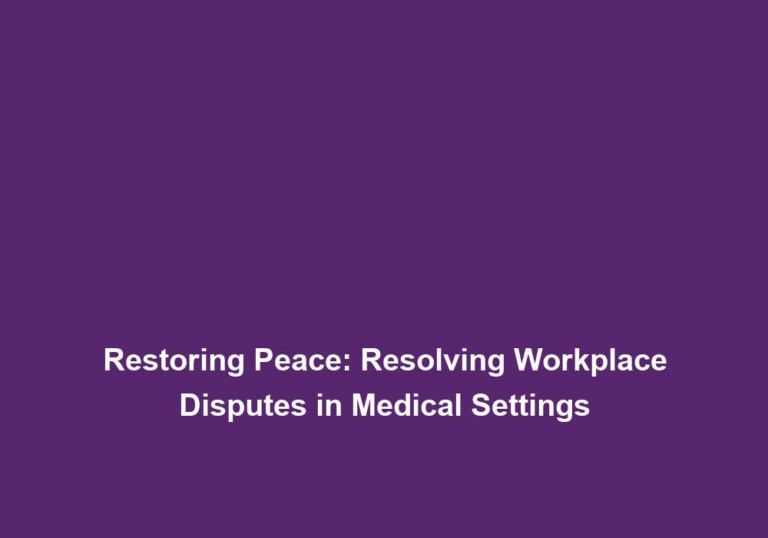Patient-First Paradigm: Best Practices to Enhance the Patient Experience
In the healthcare industry, the patient experience plays a crucial role in determining the success of a healthcare provider. A patient-first paradigm recognizes the importance of putting the patient at the center of care, prioritizing their needs, preferences, and overall satisfaction. By implementing best practices that enhance the patient experience, healthcare providers can establish trust, build loyalty, and improve the overall quality of care they deliver. In this article, we will explore various strategies and tactics that can be employed to achieve this goal.
1. Effective Communication and Active Listening
One of the fundamental aspects of providing excellent patient care is effective communication. Healthcare providers should strive to communicate clearly, concisely, and empathetically with their patients. They should explain medical information in a way that is easily understandable, avoiding complex jargon and terminology.
To ensure effective communication, healthcare providers can:
- Use plain language and avoid medical jargon to explain medical information to patients.
- Take the time to listen actively to patients, allowing them to express their concerns, fears, and expectations.
- Show empathy and understanding by acknowledging and validating patients’ emotions.
Active listening is equally important, as it allows healthcare providers to truly understand their patients’ concerns, fears, and expectations. By actively engaging in the conversation, healthcare providers can establish trust and ensure that patients feel heard and valued.
2. Personalized Care Plans
Every patient is unique, with specific medical needs, preferences, and goals. To enhance the patient experience, healthcare providers should develop personalized care plans that cater to each individual’s requirements. This involves considering the patient’s medical history, lifestyle, socioeconomic factors, and cultural background.
To create personalized care plans, healthcare providers can:
- Conduct thorough assessments of patients, taking into account their medical history, lifestyle factors, and cultural beliefs.
- Involve patients in the decision-making process, allowing them to express their preferences and goals.
- Collaborate with other healthcare professionals to ensure a holistic approach to care.
By taking a holistic approach to care, healthcare providers can ensure that patients receive treatment that is tailored to their specific circumstances, ultimately leading to better outcomes and higher patient satisfaction.
3. Streamlined Appointment Management
Long wait times and scheduling difficulties can be major sources of frustration for patients. Healthcare providers should implement systems and technologies that streamline appointment management. This could include online appointment scheduling, automated reminders, and efficient patient registration processes.
To improve appointment management, healthcare providers can:
- Implement online appointment scheduling systems that allow patients to book appointments at their convenience.
- Send automated reminders to patients regarding upcoming appointments.
- Optimize patient registration processes to minimize wait times and paperwork.
By reducing wait times and improving the overall efficiency of appointment management, healthcare providers can demonstrate their commitment to respecting their patients’ time and provide a more convenient and pleasant experience.
4. Empowered and Informed Patients
In a patient-first paradigm, it is essential to empower patients and actively involve them in their own care. Healthcare providers should educate patients about their medical conditions, treatment options, and potential risks and benefits.
To empower and inform patients, healthcare providers can:
- Provide comprehensive information about medical conditions, treatment options, and potential risks and benefits.
- Encourage patients to ask questions and actively participate in the decision-making process.
- Use visual aids, such as diagrams or videos, to enhance patient understanding.
By providing comprehensive information, patients can make informed decisions about their healthcare choices and actively participate in the decision-making process. This collaborative approach fosters a sense of ownership and empowerment, leading to improved patient satisfaction.
5. Seamless Care Transitions
Many patients receive care from multiple healthcare providers and transition between different healthcare settings. Ensuring seamless care transitions is crucial in maintaining a positive patient experience.
To ensure seamless care transitions, healthcare providers can:
- Establish effective communication channels between different providers, ensuring that essential medical information is accurately and promptly shared.
- Coordinate care plans with other healthcare professionals to ensure continuity of care.
- Provide patients with a clear roadmap for their treatment journey, including information about follow-up appointments and referrals.
This helps prevent unnecessary duplication of tests, reduces the risk of medical errors, and enhances the overall continuity of care.
6. Continuous Feedback and Improvement
To continuously enhance the patient experience, healthcare providers should actively seek feedback from their patients. This can be done through surveys, patient satisfaction questionnaires, or even personal discussions.
To gather feedback and improve, healthcare providers can:
- Implement surveys or questionnaires to gather feedback on various aspects of the patient experience.
- Actively listen to patient concerns and address them promptly.
- Analyze feedback data to identify areas for improvement and implement necessary changes.
Patient feedback provides valuable insights into areas that require improvement and helps identify areas of strength. By acting upon patient feedback, healthcare providers demonstrate their commitment to providing excellent care and continuously improving their services.
7. Cultivating a Caring and Compassionate Environment
Creating a caring and compassionate environment is vital to enhance the patient experience. Healthcare providers should focus on fostering a culture of empathy, kindness, and respect within their organizations.
To cultivate a caring and compassionate environment, healthcare providers can:
- Provide training to staff in effective communication, empathy, and cultural competency.
- Encourage staff to actively listen to patients and show empathy in their interactions.
- Design the physical environment to promote comfort and relaxation, with soothing colors, comfortable furniture, and calming artwork.
By cultivating a caring and compassionate environment, healthcare providers can make patients feel valued, safe, and supported.
Conclusion
Embracing a patient-first paradigm and implementing best practices to enhance the patient experience is essential for healthcare providers aiming to deliver high-quality care. By prioritizing effective communication, personalizing care plans, streamlining appointment management, empowering and informing patients, ensuring seamless care transitions, seeking continuous feedback, and cultivating a caring environment, healthcare providers can establish strong patient relationships, improve patient satisfaction, and ultimately achieve better health outcomes.







